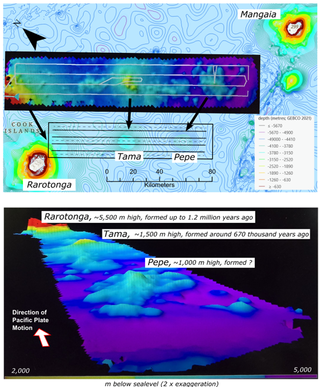A series of relatively young underwater volcanoes has been discovered under the waves of the Pacific Ocean, some of which may even be active.
The volcanoes were found during an expedition to map the seafloor near the Cook Islands in the Central Pacific, about 2,900 miles (4,700 kilometers) south of Hawaii. If these structures are volcanically active, the heat that they generate may have spawned a unique and exciting marine habitat nearby, the researchers said.
“So far, we have not seen any clear signs of volcanic activity, but then again, no one has yet had the chance to look carefully at the seabed and sample it,” representatives from the Seabed Minerals Authority (SBMA), which co-led the research, said in a statement. “Once fully processed and interpreted, our new seabed map should help any future scientists quickly go directly to the best points for this sampling.”
The Cook Islands are a group of 15 islands in the South Pacific Ocean, located between French Polynesia and American Samoa. This archipelago was created millions of years ago as the Pacific plate moved over a magma hotspot in the Earth’s mantle — similar to the way the Hawaiian Islands were formed. A magma hotspot is a localized area in Earth’s mantle where unusually hot rock rises toward the surface, causing volcanic activity. Unlike volcanoes at tectonic plate boundaries, hotspots occur in the middle of tectonic plates and remain stationary, while the plate above moves over time.

A hot mantle plume from the hotspot brings heat and magma toward Earth’s crust, which can cause magma from the mantle to erupt onto the seafloor and then cool rapidly in the water. Over time, repeated eruptions build up a volcanic structure, forming an underwater volcano. If the eruptions continue, the volcano grows large enough to break the ocean surface, forming a volcanic island.
Related: Undersea volcano off Oregon coast could erupt this year, geologists predict
Most of the volcanoes in the Cook Islands are ancient, with their rocks dating back tens or even hundreds of millions of years. However, the islands of Rarotonga and Aitutaki are made of a combination of older and younger rocks, because they are among the most recent islands to form over the hotspot — the youngest rock on Rarotonga dates back only around 1.2 million years.
These newly mapped underwater volcanoes were first theorized in 2024 after researchers discovered that the rocks of one submerged volcano were only 670,000 years old. The rocks were discovered roughly 37 miles (60 km) southeast of Rarotonga, on a volcano called Tama, and they mark the youngest volcanic rocks discovered in the Cook Islands to date.
The team also theorized that, going southeast from Rarotonga through Tama, there may be several other underwater volcanoes lurking on the seafloor, which may also be much younger than the other Cook Islands.
To investigate these structures further, the ARTEX 2025 expedition was launched to map the ocean floor in the area surrounding Rarotonga. The team discovered that there was indeed a series of smaller structures dotted along the seafloor to the southeast of Rarotonga, including a 0.6-mile-high (1 km) volcano named “Pepe”. The team’s data is yet to be fully processed, however, and the structures have not yet been confirmed as volcanically active.
The researchers hope to return to the area to learn more about the seamounts, or underwater volcanoes, and to collect samples of the rocks to figure out exactly how old they are.
US volcano quiz: How many can you name in 10 minutes?
